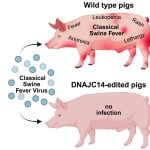It wasn’t cheap. That’s what hits you first. When Heather Broughton signed up for the CTEAM program from the George Morris Centre five years ago it cost them $5,500, a big investment for an averaged-sized farm.
After completing the course Heather and husband Greg thought it was so valuable they both signed up for the next session. Tuition kept adding up, plus air fares and expenses in cities from Halifax and Quebec City to Niagara Falls and Calgary.
Nor is the Broughton farm so big that they’re used to throwing around cheques like these without expecting a provable return, especially because they’d be investing not just money, but their precious time too.
Read Also

The wildly adaptable side of next gen agriculture
Some people just fall into the world of agriculture — and consider themselves lucky to have stumbled into such a…
The same goes for Steve Cooper, 2,000 miles away on his 100-acre farm just northeast of Toronto. Cooper’s farm is about as different from the Broughtons’ as it’s possible to get. The operation that he and wife Lisa are developing is based on vegetables and agri-tourism, making it the kind of farm where some farmers wonder if it’s really a farm at all.
By contrast, the Broughtons easily fit into anybody’s definition of what it means to be a farmer. They’re third generation on the farm at Donalda, an hour and a half southeast of Edmonton, with the next generation in the wings.
Together, with Greg’s brother and wife, Charlie and Rhonda, the Broughtons harvest 4,500 acres of canola, wheat, field peas and barley, including some custom work. The two families operate separate businesses but share equipment and labour. That strategy has allowed them some shared cost savings, yet each couple can pursue opportunities and manage risk as they deem appropriate.
Steve Cooper meanwhile had met Lisa while working at IBM. They studied agriculture together at Ridgetown College 18 years ago, and after graduating, they bought their 100-acre farm and started raising beef cattle and growing some commodity crops and sweet corn while holding down off-farm jobs.
The Coopers sold their sweet corn at a small roadside stand that Steve had run since he was a teenager. Then, in 2000, they sold their cattle and bought meat goats.
Four years later, Lisa got laid off and the Coopers knew they had to re-educate themselves to make the farm more profitable, with the goal of both of them farming full-time.
What they wanted
Though so different, the two farms felt they were in the midst of transitions that they had to get right. The Coopers needed to grow their farm in order to turn their dream into a profitable business. The Broughtons needed to grow and manage their farm to make it truly sustainable, leaving open the possibility of passing it on to the next generation.
They were also the same because they both believed that business skills are what they needed in order to make those transitions, and because they believed that education could help them sharpen those skills.
For almost 25 years, Heather had been actively involved in the business, especially loving the business operational side.
Her town-girl upbringing — she was raised by parents who ran a family business in town — gave her an outsider’s perspective, plus non-farm family objectiveness. But she also saw that business on the farm is different. “With agricultural businesses it’s more than the dollar value,” says Heather. “Decisions are often tied to emotion, too.”
Bringing those two perspectives together to achieve clear goals would take new skills, Heather thought, and she began looking at educational opportunities.
FARMERS’ SWOT
While doing a strategic plan during the CTEAM course, Steve Cooper learned a business tool called “SWOT.” Not many farmers use a Strengths Weaknesses, Opportunities and Threats analysis but many other businesses do, because it gives them a broader perspective of their current business and potential markets.
A SWOT analysis is often the first step in a strategic plan. “The best managers recognize their internal management weaknesses and strengths, and outsource where they need help or innovations,” says Jeff Johnson, senior account manager of BDO Dunwoody in the Fraser Valley, B.C. “This process (SWOT) helps business people understand their business in a whole new light.”
Formalized business discussions allow you to put all the issues on the table and keep it about business. “A SWOT can jump start discussion of what all the stakeholders want out of the farm and where you want it to go,” says Johnson. “It gets everybody going in the same direction,”
Strategic plans have actions plans in them — usually three months, six months and one year. “Strategic plans are living, breathing documents that businesses revisit one or twice a year,” says Johnson. Looking at and reviewing your SWOT helps build and change strategic plans.
The process should help you identify areas where your strengths and opportunities align with a high probability of success. Conversely, you will also identify combinations of weaknesses and threats. Your strategic plan should avoid these areas or at least provide for ways to minimize their effects on the farm business. It’s like taking a snapshot of your farm, so you can see how it’s functioning internally, and how it fits into the larger marketplace.
The first two sections of the SWOT analysis examine the internal workings of your farm business. These issues or items often are the result of efficient or inefficient use of the farm’s resources. competitive advantages can come from improving efficiency, quality, innovation, linking businesses and customer responses.
The Coopers’ SWOT analysis has helped them recognize and take advantage of their strengths and minimize their weaknesses. For example, they realized that Steve and Lisa had excellent people, promotional and adaptation skills.
The Coopers also saw the strength of having both of them working toward a common goal and for each of them doing things at which they excelled. “any weaknesses we have, we try to hire someone to do it for us,” says Lisa. in the last year, they hired someone to revamp their website ( and write a newsletter, and are in the process of hiring a bookkeeper. That freed up their time for marketing and dealing with customers — tasks at which they excel.
One weakness the Coopers are working at is tracking each of the segments of their production. It gets more time-consuming as they expand into more and more crops. The goal is to have a more advanced cost of production for each crop, even an eighth of an acre of beets.
The second part of the SWOT analysis requires you to look outside your business at issues that you cannot control but can manage to enhance or reduce their impact on your business. This helps businesses prepare and examine their financial position for things like a recession, or a subdivision being built next door, or changes in currency and interest rates. Knowing the trends of the industry is essential.
Doing a SWOT external analysis allowed the coopers to see their business from the outside and realize for the first time that they were already in the local food business, a growing trend. To take advantage of that opportunity, they now sell more vegetables directly sell to their customers.
A few years ago, they were at eight farmers markets a week, so the Coopers had a faithful group of customers who wanted to buy local and buy organic. By selling directly from the farm to these customer they’ve eliminated a link in their value-chain and now only go to a few farmers markets.
The community supported agriculture portion of their sales has grown 10 times in two years and they’ve linked with a local greenhouse grower to sell produce all year. To further market directly with consumers, this year the coopers established four acres of a fall pick-your own strawberries.
According to michael Porter of the Harvard school of business administration, five forces shape the competition in any industry. The risk of new competitors, rivalry among competitors, the ability of buyers and suppliers to bargain and the closeness of substitutes for your product or service.
“Our focus is Toronto and the suburban communities north of the city,” says cooper.
Two kilometres from their place is another farm tourism venue but there is more than enough population in the GTA for both of them, Cooper says. “Within an hour’s drive we have over a million customers.”
It wasn’t cheap. That’s what hits you first. When Heather Broughton signed up for the CTEAM program from the George Morris Centre five years ago it cost them $5,500, a big investment for an averaged-sized farm.
After completing the course Heather and husband Greg thought it was so valuable they both signed up for the next session. Tuition kept adding up, plus air fares and expenses in cities from Halifax and Quebec City to Niagara Falls and Calgary.
Nor is the Broughton farm so big that they’re used to throwing around cheques like these without expecting a provable return, especially because they’d be investing not just money, but their precious time too.
The same goes for Steve Cooper, 2,000 miles away on his 100-acre farm just northeast of Toronto. Cooper’s farm is about as different from the Broughtons’ as it’s possible to get. The operation that he and wife Lisa are developing is based on vegetables and agri-tourism, making it the kind of farm where some farmers wonder if it’s really a farm at all.
By contrast, the Broughtons easily fit into anybody’s definition of what it means to be a farmer. They’re third generation on the farm at Donalda, an hour and a half southeast of Edmonton, with the next generation in the wings.
Together, with Greg’s brother and wife, Charlie and Rhonda, the Broughtons harvest 4,500 acres of canola, wheat, field peas and barley, including some custom work. The two families operate separate businesses but share equipment and labour. That strategy has allowed them some shared cost savings, yet each couple can pursue opportunities and manage risk as they deem appropriate.
Steve Cooper meanwhile had met Lisa while working at IBM. They studied agriculture together at Ridgetown College 18 years ago, and after graduating, they bought their 100-acre farm and started raising beef cattle and growing some commodity crops and sweet corn while holding down off-farm jobs.
The Coopers sold their sweet corn at a small roadside stand that Steve had run since he was a teenager. Then, in 2000, they sold their cattle and bought meat goats.
Four years later, Lisa got laid off and the Coopers knew they had to re-educate themselves to make the farm more profitable, with the goal of both of them farming full-time.
What they wanted
Though so different, the two farms felt they were in the midst of transitions that they had to get right. The Coopers needed to grow their farm in order to turn their dream into a profitable business. The Broughtons needed to grow and manage their farm to make it truly sustainable, leaving open the possibility of passing it on to the next generation.
They were also the same because they both believed that business skills are what they needed in order to make those transitions, and because they believed that education could help them sharpen those skills.
For almost 25 years, Heather had been actively involved in the business, especially loving the business operational side.
Her town-girl upbringing — she was raised by parents who ran a family business in town — gave her an outsider’s perspective, plus non-farm family objectiveness. But she also saw that business on the farm is different. “With agricultural businesses it’s more than the dollar value,” says Heather. “Decisions are often tied to emotion, too.”
Bringing those two perspectives together to achieve clear goals would take new skills, Heather thought, and she began looking at educational opportunities.














